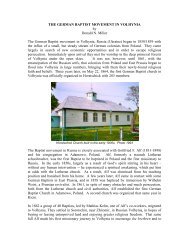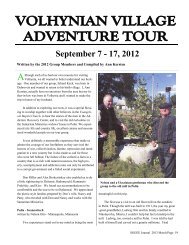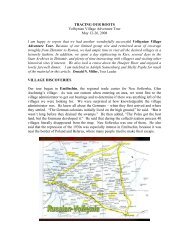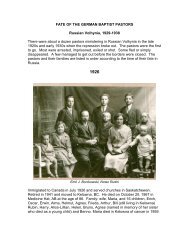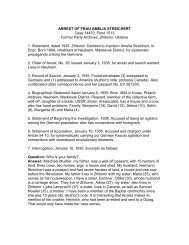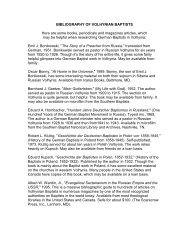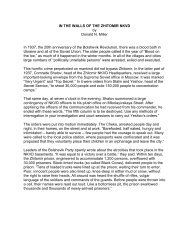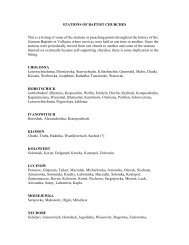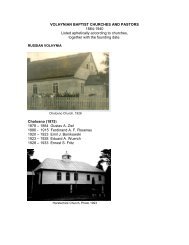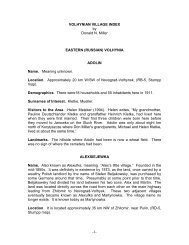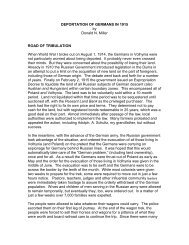german baptist settlements in western canada - Volhynia
german baptist settlements in western canada - Volhynia
german baptist settlements in western canada - Volhynia
Create successful ePaper yourself
Turn your PDF publications into a flip-book with our unique Google optimized e-Paper software.
VOLHYNIAN BAPTIST SETTLEMENTS<br />
IN WESTERN CANADA<br />
by<br />
Donald N. Miller<br />
There were three major movements of German Baptists from <strong>Volhynia</strong> who<br />
settled <strong>in</strong> Western Canada. The first took place <strong>in</strong> the early 1890s until shortly<br />
after the turn of the century. The second occurred from 1926-1928. And the<br />
third covered the period from 1947 to 1972. Of course, there were some<br />
German Baptists from <strong>Volhynia</strong> who immigrated to Canada prior to that time and<br />
subsequent to it, but the major <strong>settlements</strong> took place <strong>in</strong> these three phases.<br />
The First Wave, 1892-ca 1903<br />
The first wave began with the organization of the first German Baptist Church <strong>in</strong><br />
Western Canada <strong>in</strong> 1886. It was located at Edenwald, near Reg<strong>in</strong>a,<br />
Saskatchewan. Although it was comprised primarily of people from Romania, it<br />
sensitized the leaders of the General Missionary Society of the German Baptist<br />
Churches of North America to the grow<strong>in</strong>g opportunity of m<strong>in</strong>istry among Baptists<br />
from Eastern Europe. That same year the Rev. F. A. Petereit , a young<br />
theological graduate from the German Department of the Rochester Baptist<br />
Sem<strong>in</strong>ary, came to W<strong>in</strong>nipeg, Manitoba to work with some 20 German-speak<strong>in</strong>g<br />
Baptists, who had gathered together <strong>in</strong> a German Bible class <strong>in</strong> an Englishspeak<strong>in</strong>g<br />
church. Some of them had come from <strong>Volhynia</strong>, Russia. Three years<br />
later, on December 31, 1899, the German Baptist Church <strong>in</strong> W<strong>in</strong>nipeg was<br />
officially organized as a congregation. It soon became the mother church of<br />
many daughter churches <strong>in</strong> the West, as most German Russian immigrants, after<br />
mak<strong>in</strong>g a brief stopover <strong>in</strong> W<strong>in</strong>nipeg, moved on to the West where homesteads<br />
were still available. Upon arrival, they soon gathered for worship and <strong>in</strong> time<br />
established new churches.<br />
In September 1892, dur<strong>in</strong>g one of his missionary adventures to the North West,<br />
together with several German Baptist delegates from Manitoba and Saskatewan,<br />
Petereit formally recognized the first German Baptist Church <strong>in</strong> Alberta. It was<br />
located <strong>in</strong> Rabbit Hill, just south of Edmonton and called the Heimthal German<br />
Baptist Church. Among the 17 charter members were a number of German<br />
Baptist families from <strong>Volhynia</strong>. Later, they called Rev. F. A. Mueller from Texas<br />
to become their first full-time pastor. Mueller had been pastor of a large German<br />
Baptist congregation <strong>in</strong> Luc<strong>in</strong>ow, <strong>Volhynia</strong>, when he was forced out of the country<br />
for baptiz<strong>in</strong>g several Russians, which was strictly forbidden by the law. Mueller<br />
moved to Rabbit Hill <strong>in</strong> 1893 and took up the work. His com<strong>in</strong>g opened the<br />
floodgates for many German Russian immigrants to come to America.<br />
Accord<strong>in</strong>g to David T. Priestley, former professor of Historical Theology at the<br />
Edmonton Baptist Sem<strong>in</strong>ary, “After com<strong>in</strong>g to Rabbit Hill, Mueller arranged for
nearly 50 families to come from <strong>Volhynia</strong> to Canada. First, they jo<strong>in</strong>ed the Rabbit<br />
Hill Baptist Church; then, because the majority were homestead<strong>in</strong>g<br />
<strong>in</strong>conveniently far to the southeast, they organized a new congregation near<br />
Leduc. Soon after, Mueller resigned as pastor at Rabbit Hill to give more time to<br />
the larger church at Fredericksheim and the various stations it had begun near<br />
Wetaskaw<strong>in</strong> and Millet.” (Plant<strong>in</strong>g Churches <strong>in</strong> Alberta: 1890 to 1920, by David<br />
T. Priestley <strong>in</strong> the Baptist Herald).<br />
Mueller was a tireless pioneer missionary worker and evangelist. He not only<br />
recruited many German Baptists from <strong>Volhynia</strong>, but founded many new German<br />
Baptist congregations, largely with<strong>in</strong> a 200-mile triangle <strong>in</strong> Central Alberta.<br />
Together with German Baptist immigrants, he was <strong>in</strong>strumental <strong>in</strong> organiz<strong>in</strong>g 10<br />
churches <strong>in</strong> Western Canada, <strong>in</strong>clud<strong>in</strong>g the East Bittern Lake Baptist Church,<br />
founded <strong>in</strong> 1901, which I attended as a boy. Among the charter members was<br />
the large well-known August L<strong>in</strong>k family from Rogowka, <strong>Volhynia</strong>, who had filed<br />
for a homestead <strong>in</strong> the area <strong>in</strong> 1900. It has been suggested that Central Alberta<br />
has the largest concentration of Germans from <strong>Volhynia</strong> (and Poland) that can be<br />
found anywhere <strong>in</strong> the world today, and that one million Canadians claim whole<br />
or partial Ukra<strong>in</strong>ian ancestry.<br />
Many of the Germans from <strong>Volhynia</strong> <strong>in</strong> this first wave of immigration to Canada<br />
came <strong>in</strong> search of a better way of life and <strong>in</strong> order to escape the Russian draft.<br />
The Second Wave, 1926-1928<br />
In the second wave, the reasons for leav<strong>in</strong>g Russia were more complicated and<br />
critical. With the Bolshevik take over <strong>in</strong> Russia, religious oppression,<br />
collectivization, and nationalization of land, many Germans reasoned that the<br />
time to leave had come. As early as 1922, reports and stories of hardship and<br />
suffer<strong>in</strong>g of the Volksdeutsche had come to the attention of Dr. Wilhelm Kuhn,<br />
General Secretary of the German Baptist Missionary Society. In 1926, Kuhn,<br />
together with E. P. Wahl, Hermann Streuber and F. A. Bloedow, spiritual leaders<br />
among the German Baptists, determ<strong>in</strong>ed to undertake a relief program whereby<br />
German Baptists from Russia would be brought to Canada <strong>in</strong> cooperation with<br />
the two Canadian railroads, which were eager to settle people <strong>in</strong> Western<br />
Canada. S<strong>in</strong>ce many Canadian farmers were look<strong>in</strong>g for cheap farm labor and<br />
the railroads were eager to settle the farms, this proved beneficial for both. As it<br />
turned out, it was also beneficial to the German Baptist movement <strong>in</strong> Western<br />
Canada, as most of these people jo<strong>in</strong>ed the Baptist Church or organized new<br />
congregations.<br />
It was not until 1926, however, that the German Baptist Relief and Immigration<br />
program got under way. On June 1, 1926, Wilhelm Kuhn wrote, “We are<br />
br<strong>in</strong>g<strong>in</strong>g about 500 people from Russia, pr<strong>in</strong>cipally from Wolhynia. It is quite<br />
remarkable that these people can pay all their own transportation…In addition to<br />
these 500 people, we have thousands more <strong>in</strong> our files, who are anxiously
plead<strong>in</strong>g to be brought to Canada.” (Baptist Herald, June 1, 1926, p. 11). By the<br />
end of the year the German Society had brought 270 people to Western Canada,<br />
though not all came from <strong>Volhynia</strong>. In 1928 approximately 170 persons from the<br />
German Baptist Church <strong>in</strong> Rozyszcze alone immigrated to Canada. Most of<br />
them settled <strong>in</strong> the M<strong>in</strong>itonas/Swan River area, <strong>in</strong> northern Manitoba. Robert J.<br />
Jacksteit, the former pastor who then lived <strong>in</strong> M<strong>in</strong>itonas assisted <strong>in</strong> the<br />
resettlement process. The program came to an abrupt halt <strong>in</strong> the latter part of<br />
1928, (though a few slipped through as late as the fall of 1929) when the Russian<br />
Government closed the borders and refused to process anymore applications for<br />
immigration. It is not known how many people eventually came to Canada as a<br />
result of this program, but here is a list of some of them:<br />
Adolph and Paul<strong>in</strong>e Bandzmer<br />
Herta, Eugen, Erna<br />
Arrived <strong>in</strong> Halifax, NS on October 18, 1928.<br />
Emil and Maria Bonikowski<br />
Erich, Oscar, Erw<strong>in</strong>, Alma, Helmut, Frieda, Arthur, Bill, Rub<strong>in</strong>, Harry, Alice-<br />
Lillian, Helen, Agnes<br />
Arrived <strong>in</strong> Quebec, ONT. on May 23, 1927<br />
Albert and ____Bred<strong>in</strong><br />
Arrived <strong>in</strong><br />
Karl and Augusta Busch<br />
Herta, Re<strong>in</strong>hart<br />
Arrived <strong>in</strong> Quebec, ONT on May 23, 1927<br />
Albert and Julia Edel<br />
Berta, Albert, Arthur, Sarah, Emma, Richard<br />
Arrived <strong>in</strong> Halifax, NS <strong>in</strong> October __1926<br />
Ludwig Edel<br />
Arrived <strong>in</strong><br />
Richard Eggert<br />
Leonid Eggert<br />
Arrived <strong>in</strong> Halifax, NS on October 18, 1928<br />
Emma Gieger<br />
Berta, Wanda<br />
Arrived <strong>in</strong><br />
Rudolf and Emma Gust<br />
Lena, Manuel<br />
Arrived <strong>in</strong>-----on October 27, 1927.
Herbert Ikkert<br />
Arrived <strong>in</strong><br />
David and ____Ittermann<br />
Arrived <strong>in</strong> St. John, NB on January 4, 1927<br />
Krueger<br />
Leander and Olga Kuhn<br />
Meta<br />
Arrived <strong>in</strong><br />
Re<strong>in</strong>holt and Lydia Lamprecht<br />
Lydia, Lily, Alfonze<br />
Arrived <strong>in</strong> Halifax, NS, March 28, 1928<br />
Edmund and Olga Lange<br />
Assaf, Agatha, Alitza<br />
Arrived <strong>in</strong> Quebec, ONT. On August 5, 1927.<br />
--------Lueck<br />
Hugo<br />
Arrived <strong>in</strong> on<br />
Richard and Marie Milke<br />
Harry<br />
Arrived <strong>in</strong> Halifax, NS on October 18, 1928<br />
Samuel and Tusnelda Mueller<br />
Arrived <strong>in</strong> Sa<strong>in</strong>t John, NB on February 8, 1927<br />
Otto and Herta Nashilewski<br />
Arrived <strong>in</strong> Halifax, NS on July 5, 1928.<br />
Alexander Richter<br />
Arrived <strong>in</strong> Halifax, ONT. on December---,1926.<br />
Adolf and Angela Rentz<br />
Lydia, Reuben, Eugene, Waldie, Willie, Eric and Agnes.<br />
Arrived <strong>in</strong> Halifax, NS on<br />
Alexander Richter<br />
Arrived <strong>in</strong> Halifax, ONT on December__1926<br />
Jonathan Richter
Jonathan and Olga Schlender<br />
Nellie<br />
Arrived <strong>in</strong> Quebec, ONT. September 17, 1926<br />
Adoph and Elsa Schultz<br />
Ad<strong>in</strong>a, L<strong>in</strong>da, Sarah, Assaph, Bernard, Jonathan<br />
Arrived <strong>in</strong> Halifax, NS on June 11, 1927<br />
Johann and Berta Siss<br />
Albert, Adel<strong>in</strong>e, L<strong>in</strong>da, Alica<br />
Arrived <strong>in</strong> Halifax, NS <strong>in</strong> July__1928<br />
Emil and Olga Stober<br />
Gertrud, Ella, Frieda, Paul, Mary, Elsie, ???<br />
Arrived <strong>in</strong> November 16, 1928<br />
Albert and Tabea Tiede<br />
Leon, Egardt<br />
Arrived <strong>in</strong> Quebec, Quebec July.1926<br />
Edward and Matilda Wuerch<br />
Arthur, Alice, Wilhelm, Angelica<br />
Arrived <strong>in</strong> Halifax, NS on __________<br />
The Third Wave, 1947-1972<br />
The third wave of German Baptist settlers <strong>in</strong> Western Canada began when<br />
Canada reopened its gates to German immigrants <strong>in</strong> 1947. In that year the North<br />
American Baptist Conference (formerly the General Missionary Society of the<br />
German Baptist Churches of North America) created an immigration and<br />
colonization society for the express purpose of br<strong>in</strong>g<strong>in</strong>g Baptist refugees from<br />
Germany to Canada. Initially only those classified as Volksdeutsch were<br />
admitted. German nationals rema<strong>in</strong>ed “prohibited enemy aliens” until September<br />
1950. The mass migration to Canada follow<strong>in</strong>g World War II resulted from a<br />
powerful “push and pull” factor. Pressure to emigrate came from the unsettled<br />
conditions of those uprooted by the war and the search for a better life <strong>in</strong> the new<br />
world.<br />
William Sturhann, a German Baptist pastor from Morris, Manitoba, who played an<br />
important role <strong>in</strong> the immigration process, gave an additional reason for his<br />
denom<strong>in</strong>ation’s <strong>in</strong>volvement <strong>in</strong> the resettlement program. He said, “S<strong>in</strong>ce we <strong>in</strong><br />
Canada desperately needed to…add to our church membership, we looked at<br />
immigration not only as a matter of relief for the refugees, but also as a matter of<br />
economic necessity and self-help.” (They Came From the East and West, p. 12).
Most of the Germans were resettled <strong>in</strong> the early 1950s, though the resettlement<br />
of refugees cont<strong>in</strong>ued for a number of years thereafter. By the end of 1972 over<br />
7,000 had entered Canada through the German Baptist immigration and<br />
colonization program. Included <strong>in</strong> this group were many men, women and<br />
children from <strong>Volhynia</strong> who had fled ahead of the advanc<strong>in</strong>g Russian army. In a<br />
quick glance at Sturhan’s partial list<strong>in</strong>g of German Baptists who were resettled to<br />
Canada, I recognized the follow<strong>in</strong>g family names as those hav<strong>in</strong>g come from<br />
<strong>Volhynia</strong>: Goetze Hart, Kerber, Kluttig, Kupsch, Mueller, Pelzer, Rapske, Stober,<br />
Tutschek . Obviously there were many more. Nevertheless, it was a significantly<br />
smaller wave of immigrants from <strong>Volhynia</strong> than the first two waves.<br />
As part of the resettlement program, refugees were guaranteed employment.<br />
The orig<strong>in</strong>al <strong>in</strong>tention was to place the refugees with German-speak<strong>in</strong>g farmers<br />
who were anxious to have farm workers. But it was soon learned that many of<br />
the refugees lacked the necessary skills to work on a farm, which necessitated<br />
f<strong>in</strong>d<strong>in</strong>g them other jobs. Most were placed <strong>in</strong> pack<strong>in</strong>g houses, mach<strong>in</strong>e shops,<br />
mills, railroad yards, brick factories, tobacco fields, automobile <strong>in</strong>dustries, lumber<br />
cutt<strong>in</strong>g factories, fruit fields, construction sites, and m<strong>in</strong><strong>in</strong>g and logg<strong>in</strong>g<br />
operations. The largest number of refugees were settled <strong>in</strong> W<strong>in</strong>nipeg, Morris,<br />
M<strong>in</strong>itonas, Reg<strong>in</strong>a, Yorkton, Saskatoon, Whitemouth, Edmonton, Calgary,<br />
Medic<strong>in</strong>e Hat, Cranbrook, Pr<strong>in</strong>ce George, Pr<strong>in</strong>ce Rupert and Vancouver, as well<br />
as Hamilton, Kitchener, W<strong>in</strong>dsor and St. Cather<strong>in</strong>es <strong>in</strong> Ontario. As a result of the<br />
resettlement of German Baptists <strong>in</strong> Western Canada, the benefits to the<br />
denom<strong>in</strong>ation were extensive as many of the refugees jo<strong>in</strong>ed churches of the<br />
North American Baptist Conference, and many new churches were added.



